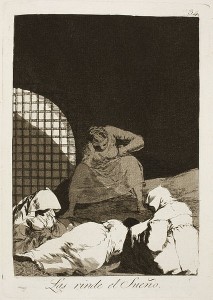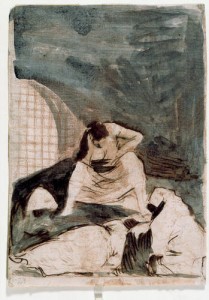

I have just acquired two prints by Goya from his Los Caprichos series. “Las rinde el Sueño” (Sleep overcomes them) and ““Que Pico de Oro!”( What a golden beak). According to the Davidson Gallery brochure, these prints are part of the fifth edition printed between 1881 – 1886. It is astounding that the gallery made them affordable. The thrill of having two real Goya prints in my life inspires me to write about them.
Los Caprichos relates to the idea of “sights,” as in Italian landscape conventions. In most cases Los Caprichos has been translated as “follies,” a more specific characterization of what Goya is representing.
Goya described the series as depicting “the innumerable foibles and follies to be found in any civilized society, and from the common prejudices and deceitful practices which custom, ignorance, or self-interest have made usual.”
But these foibles are frequently represented by imaginary monsters or grotesque looking creatures and people. At the time that Goya created Los Caprichos, (1793 – 1798) he had just recovered from a grave illness that left him entirely deaf. Although he continued as the prominent court artist that he had been since 1789, he could no longer hear. While we might like to think that this heightened his observation of behavior as acted out by postures and clothing, Goya’s postures, as well as grotesque physiognomies, are emblematic of moral states: the artist declared that ” he has neither imitated other works, nor even used studies from nature . . . the artist may… remove himself entirely from nature and depict forms of movements which to this day have only existed in the imagination.”
“Sleep overcomes them” includes four women in various awkward positions. One women lies on the ground, and appears to be sick unto death, while the other three are keeping vigil (one is praying over her, the other about to cover her).
As Fred Licht has commented so brilliantly, the blackness above them does not suggest sky, the light does not give light, these are formal qualities that are imaginary; they enhance the emotional tenor of hovering between life and death. We do not know if these women are inside or outside, that ambiguity is also essential Goya. This print, like so many of Los Caprichos hovers between dream and reality, sleeping and awake, consciousness and unconsciousness. ( Fred Licht, Goya, Abbeville Press, 2001 and Goya, The Origins of the Modern Temper in Art, 1981.)
One analysis of the Caprichos suggests that there are four aspects to the series, condemnation of society’s traditional vices, deceit in relationships between men and women, protest against abuse of power, and satirical comments on poor education and ignorance. 

Sleep Overcomes Them would connect to these themes. The vice here is one we are familiar with today, the desperation of the poor who lack sufficient housing, food, and love. The seated woman is the center of the print, she has firmly planted her feet conveying her strength and endurance, but her upper body suggests, at this moment, almost surrender to defeat, both in helping the woman lying on the ground, and in overcoming her own adversity and poverty and exhaustion.
The only drawings I have seen of homeless that somewhat echo the subtlety of Goya are by Olga Chernysheva, a Russian artist. Her drawings reflect the legacy of figurative training in the old Soviet Union. She suggests survival based on a single luxury that enables life to continue typed in small letters on a piece of paper attached to the drawing, a coat on the left, a smoke on the right. Chernysheva spends a lot of time walking the streets and observing the people left behind in the new capitalist Russia, but as with Goya, these postures convey more than factual observation.
Long before Marx, Goya recognized that the wealthy sit on the backs of the poor, that the privileged are essentially the monsters and hypocrites that we see in Los Caprichos.
The dialectic partner of Sleep Overcomes Them is my second Goya, Que Pico de Oro! (What a Golden Beak). We see a parrot sitting on a podium like box, gesturing as in giving a speech. Surrounding him are men in various stages of consciousness. The image evokes a courtroom scene, with a single figure behind the parrot, and the others clustered below him. The figure in the foreground seems to be in a worshipful position, others have raised their heads and opened their mouths as though entranced. Another man looks dubious, two others look like collaborators, evil smirks on their faces.
How can I see this and not think of the Trayvon Martin trial, (only one random reference, there are hundreds of course) whose verdict today let off George Zimmerman from any wrong doing. What but a golden beak and and half conscious magistrates would fall for any argument that let off a man who had pursued a young unarmed black teenager in a car and then on foot, then shot him dead in the heart. Michelle Alexander has explained the deep racism of the Criminal Justice System in her book The New Jim Crow. If you have read the book, the verdict is not a surprise, but it is still horrifying.
But What a Golden Beak also speaks to me of our government, with its golden tongue, particularly of President Obama, who spins webs with his speeches, deluding and lulling us with his words, even as his deeds are leading directly to the death of so many people as well as the planet
itself.
To return again to Fred Licht , Goya is the “first spokesman of a modern view of man that despairs of our intellectual capacity, has lost its faith in the essential nobility and purpose of our destiny, and stands bewildered within a dark universe in which law, order and dignity are no longer visible or attainable ideals.”
That is pretty powerful and of course I myself am an activist, and believe resistance and outrage is essential as have thousands of people this week in response to the Trayvon Martin verdict. We were sleeping in a myth of progress on civil rights, and now we awaken, but to what state, to what future? That is for us to determine.